“Destination Asia:
Flying Over Stereotypes ”
Artists - participants of the exhibition
Tajikistan
Gulyandom Moukhabbatova and Daler Rakhmatov
Gulyandom Moukhabbatova graduated from the Moscow State Institute of Culture in 1972. She lives in Dushanbe . Producer of a series of documentary movies: “Gozi Niaz” (1992), “Pain of the Soul” (1994), “Peace Ambassador” (1996), “Time cup” (2000), “My Homeland” (2002), “Child's dreams” (2005). The winner of movie awards: Saint Anna ( Moscow , 2005), Muslim's Movies ( Kazan , 2005), New Movie of 21st Century ( Smo lensk , 2005), For Humaneness ( Baku , 2005), 2nd Central Asian Movie Festival ( Tashkent , 2006), Eurasia (Almaty, 2006) .
Daler Rakhmatov was born in 1977. He graduated from the Tajik State University and from the Tajik Institute of World Economy. He lives in Dushanbe . Producer of documentary movies: “Step by Step to Tajikistan” (2006), “The Other Childhood” (2006), “We Will Make the World Better” (2006), Daler participated in the movie festivals Berlin – Pacific Asia (2005), and the 28th Moscow Movie Festival (2006).
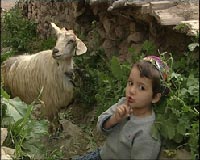 “Ovora”, 2005. Video, 60 min.
“Ovora”, 2005. Video, 60 min.
Produced by “Tajikfilm”.
Cameraman: Zikrie Isroilov,
Music by Ikbol Zavgibekov,
Producer: Akmal Khassanov,
Cast: Alidjon Shokirov, Fotima Goulomova, Abdukholik Suffiev, Sharaf Sodikov.
This video is dedicated to one of the most critical problems in contemporary Tajikistan – labor migration. The country is having difficult days after the Civic War (1992-1994), and men are leaving their land looking for jobs in Russia . The boy Abdullo stays with his grandmother and the blind grandfather, facing good and bad days in the village.
Kyrgyzstan
Ulan Dzhaparov
Ulan Dzhaparov was born in 1960, he is graduated from Kyrgyz Polytechnic Institute. He lives in Bishkek. Major exhibitions: “Plus – Minus” (Museum of Art, Bishkek, 1999), “Communications” (SCCA, Almaty, 2000), “No Mad's Land” (House of World Culture, Berlin, 2002), “Transforma” (Center for Contemporary Art – Geneva, 2002), “VideoIdentity” (SCCA, Almaty, 2004), The 2nd Biennale in Tashkent (2003), “In the Shade of Heroes” (Bishkek, Alatoo Square, 2005), “Film Focus” (Z33, Hasselt, Belgium, 2006), “Paradoxes of Polarity” (Bose Pacia Gallery, New York, 2007).
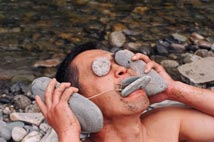 “Nothing….”, 2003. Photo series
“Nothing….”, 2003. Photo series
Performance participants: Vladimir Nazanski, Aitegin uulu Murat.
Photo by Alexander Bobkin
In the performance by the Kyrgyz artist the ancient Chinese saying “I see nothing, I hear nothing, I say nothing” takes on barbarian meaning, either it's Timur's punishment of his enemies, or mafia fights in Sicilia. The exhibition exemplifies the nations' indifference to the lives of its own people which is very typical nowadays in Central Asia – demonstrated through the artists' pictures.
Kazakhstan
Oxana Shatalova, Alla Girik
Oxana Shatalova was born in 1972 and graduated from Rudny Industrial College . She lives in Rudny City . Major exhibitions: ”VideoIdentity” (SCCA, Almaty, 2004), Photo biennale in Brescia (2006), 15th Movie and Video Festival Cabbagetown ( Toronto , Canada , 2006), 10th Media Art Biennale “Freewaves” ( Los Angeles , 2006), “Portrait – Show for Wifleem – Show for the world” (Casoria Contemporary Art Muzeum, Napoli , 2006), 2nd Moscow Biennale (Wine Factory, Moscow , 2007), 1st Contemporary Art Biennale ( Thessaloniki , 2007).
Alla Girik (1965-2006) graduated from the Rudny Industrial College , lived and has worked in Rudny. Major exhibitions: “VideoIdentity” (SCCA, Almaty, 2004), “Taking Utopia” (Digital Culture Center Fournos, Athens, 2005), Video and Digital Art Festival VAD (Gerona, Spain, 2005), Photo Biennale in Breshia (Italy, 2006), 15th Movie and Video Festival Cabbagetown (Toronto, 2006), 10th Media Art Biennale “Freewaves” (Los Angeles, 2006), “Portrait – Show for Wifleem – Show for the world” (Casoria Contemporary Art Museum, Napoli, 2006).
“Biotech”, 2006. Photo series
Pictures show the connections between the nature and culture (the second nature).
Oxana Shatalova
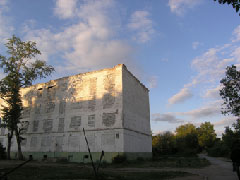 “Preservation”, 2007. Video performance and photographs.
“Preservation”, 2007. Video performance and photographs.
The Rudny city in the Northern Kazakhstan is the result of Soviet enthusiasm, it is one of the “komsomol” projects in 1960s. Young communists, “komsomol” arrived here from the different places of the Soviet Union to build the new city next to an iron mine. The buildings shown on video and photographs are the first residentials buildings in the town – dormitories for builders. Now these buildings are “preserved” on film, there was no money to reconstruct them or tear them down. Windows in these buildings are closed out by bricks while the buildings themselves are painted in bright colors. They look like absurd monuments for the 1960s.
Yerbossyn Meldibekov
Was born in 1964. He graduated from the Almaty Theater and Art Institute and lives in Almaty. Personal exhibitions: “Kazakh Style Kitch” (Kokserek Gallery, Almaty, 1997), “Erbossyn Meldibekov” (VN Gallery, Zagreb , 2000), “Hyper Muslim” (Guelman Gallery, Moscow , 2006), “Pastan” (Nina Lumer Gallery, Milano, 2006), “Pastan” ( Folker Dill , Berlin , 2006), “Centauromachy” (SCCA, Almaty, 2007). Major group exhibitions: “Le tribu dell' Arte” (City Exhibition Hall, Rome, 2001), “No Mad's Land” (World Culture House, Berlin, 2002), “Transforma” (Center for Contemporary Art – Geneva, 2002), “Politic/Um” (Prague Grad, Prague, 2004), “People and Shadows” (CANAYA Gallery, Mexico City, 2003), “Privatization” (KW Institute of Contemporary Art, Berlin, 2004), 51st Venice Biennale (Central Asia Pavilion, 2005), “Tamerlan's Syndrome” (Palazzo dei Setti, Orvieto, 2005; Haggerty Museum, Milwaukee, 2006), “Contemporary Art from Central Asia” (Uazdovski Palace, Warsaw, 2006), 10th Media Art Biennale “Freewaves” (Los Angeles, 2006), 2nd Moscow Biennale (Central Exhibition Center, Moscow, 2007), “Time of Storytellers” (Kiasma, Helsinki, 2007), “Thaw, or In the middle of the road” (Russian Museum, Saint Petersburg, 2007).
“The Monument to a Hero”, 2000. Installation
“Pastan”, 2003. Video
“Gindukush”, 2007. Installation
“Chingiz Khan's Map, or The Red Horse's Skin”, 2007. Photo Installation
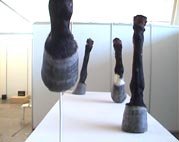 This set of art works is the result of the artists' views about Central Asia 's past and about its modern status and its role in the world history. “The Monument to a Hero” is the reply on new “epidemic” creation of monuments to historical persons on horses which take place throughout the Central Asian republics. This work introduces the idea that some new real hero will soon appear. “Pastan” is an ironic, though tough movie about the humble (submissive) eastern man. The person, for hours sitting under a hailstones of slaps in the face is the artist who takes all of a trouble of his time and the country. “Gindukush” and “Chingiz Khan's Map” also connects history with present day by ways of ancient warriors and modern “peaks of aggression”, considered probably the most dangerous geopolitical situation in the world.
This set of art works is the result of the artists' views about Central Asia 's past and about its modern status and its role in the world history. “The Monument to a Hero” is the reply on new “epidemic” creation of monuments to historical persons on horses which take place throughout the Central Asian republics. This work introduces the idea that some new real hero will soon appear. “Pastan” is an ironic, though tough movie about the humble (submissive) eastern man. The person, for hours sitting under a hailstones of slaps in the face is the artist who takes all of a trouble of his time and the country. “Gindukush” and “Chingiz Khan's Map” also connects history with present day by ways of ancient warriors and modern “peaks of aggression”, considered probably the most dangerous geopolitical situation in the world.
Said Atabekov
Was born in 1965 in the village of Bes Terek in Uzbekistan . He graduated from the Chimkent Art College and lives in Chimkent ( Kazakhstan ). Personal exhibitions: “I am Not We” (Fonkor Gallery, Chimkent, 1993), “Way to Rome ” (SCCA, Almaty, 2007). Major group exhibitions “No Mad's Land” (World Culture House, Berlin, 2002), “Transforma” (Center for Contemporary Art–Geneva, 2002), “People and Shadows” (CANAYA Gallery, Mexico City, 2003), “VideoIdentity” (SCCA-Almaty, 2004), 4th Performance Quadrenniale (Prague, 2004), 51st and 52nd Venice Biennale (Central Asia Pavilion, 2005-2007), 9th Biennale in Istanbul (2005), Tamerlan's Syndrome (Palazzo dei Sette, Orvieto, 2005; Haggerty Muzeum, Milwaukee, 2006), “From Red Star to The Blue Cupola” (IFA Gallery, Berlin-Schtuttgart, 2005-2006), “Rose of Peace” (Spiridonov House, Moscow, 2006), “Contemporary Art from Central Asia” (Uazdovski Palace, Warsaw, 2006), 10th Media Art Biennale “Freewaves” (Los Angeles, 2006), “The Time of Storytellers” (Kiasma, Helsinki, 2007).
“Walkman”, 2005. Video, 12 min
“Untitled”, 2006. Installation
“The Way to Roma”, 2007. Photographs
“Fighting for Square”, 2007. 4-channel video
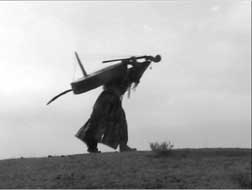 Said Atabekov lives in the very traditional part of country, in the South. Therefore his works are closer to the folk elements and present ideas of rituals. The artist has a kind of intellectual fun working with folk rituals. In the series of photographs “Way to Rome ” and in the video “Walkman” he shows how Kazakhstan moves slowly and the same time ambitiously toward progress and to civilization. The video “Fighting for Square” connects thoughts about warriors from the past and the absurd of nowadays through the traditional game of horse riders. The installation “Untitled” tells about worries of Asia in the 21st century.
Said Atabekov lives in the very traditional part of country, in the South. Therefore his works are closer to the folk elements and present ideas of rituals. The artist has a kind of intellectual fun working with folk rituals. In the series of photographs “Way to Rome ” and in the video “Walkman” he shows how Kazakhstan moves slowly and the same time ambitiously toward progress and to civilization. The video “Fighting for Square” connects thoughts about warriors from the past and the absurd of nowadays through the traditional game of horse riders. The installation “Untitled” tells about worries of Asia in the 21st century.
Dastan Kozhakhmetov
Dastan Kozhakhmetov was born in 1978 and graduated from the State Art Academy . He lives in Almaty. Major exhibitions: “Asia Art” (Central Exhibition Hall, Tashkent, 1997), “Almaty Stupid Art” (Voyager Gallery, Almaty, 1997), “Human Rights: Terra Incognita” (Kazakh Business Center, Almaty, 1997), “Patriotic Project” (Kazakh Art Museum, Almaty, 1998), “4th International” (State History Museum, Almaty, 1998), “Political Sparring” (Kazakh Art Museum, Almaty, 1999), “Master Class Festival” (Gallery Tengi Umai, Almaty, 2002), “Barrel.kz” (SCCA, Almaty, 2006). Curated the series of Kazakhstan artist's personal and group exhibitions in Soros Center for Contemporary Art - Almaty: “Femikhat”, “Centauromachy”, “Intim-In Time”, “The Way to Rome ”, “Nif-Nif&Nuf-Nuf”, “Non Eroticism” (all - in 2007).
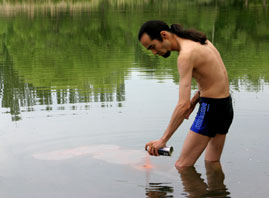 “Graffiti On The Water”, 2007. Video
“Graffiti On The Water”, 2007. Video
Simple at first sight, this work intrigues us with various meanings, illusions, hints and references. Timeless and transitory ancient Turks signs and the painting of Petroff-Vodkin “Red horse's bath” (the classical example of Russian Modernism), water and rocks, mixing fire-red color and icy coldness of the mountain lake – transgressions, metaphors and contiguities, show contrary status and role of the Central Asian region in the new civilization and in new technologies world.
Almagul Menlibayeva
Was born in 1969, she graduated from the Almaty Theater and Art Institute. She lives in Berlin . Personal exhibitions: “Magic portraits of women” (Artra Gallery, Amsterdam , 2002), “On the road” (Davide Gallo Gallery , Berlin , 2007). Major group exhibitions: “No Mad's Land” (World Culture House, Berlin, 2002), “VideoIdentity” (SCCA- Almaty, 2004), “People and Shadows” (CANAYA Gallery, Mexico City, 2003), 51st and 52nd Venice Biennale (Central Asia Pavilion, 2005-2007), “Tamerlan's Syndrome” (Palazzo dei Sette, Orvieto, 2005; Haggerty Museum, Milwaukee, 2006), “La mocca della idée” (Sala Santa Rita, Rome, 2005), “From the Red Star to The Blue Cupola” (IFA Gallery, Berlin-Schtuttgart, 2005-2006), 15th Biennale in Sidney (2006), “Contemporary Art from Central Asia” (Uazdovski Palace, Warsaw, 2006), “Peace Rose” (Spiridonov House, Moscow, 2006), Photo Biennale in Brescia (2006), “The Paradoxes of Polarity” (Bose Pacia Gallery, New York, 2007), “Thermocline” (ZKM, Karlsrue, 2007), “Time of Storytellers” (Kiasma, Helsinki, 2007).
“Apa”, 2003. Videoperformance
(Courtesy galerie davide gallo, Berlin )
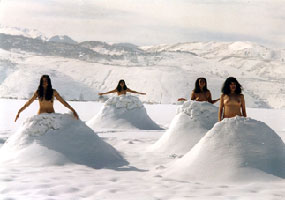 Even though women in Kazakhstan are Asian women, often they were the main person in family, and at times governed the entire tribe. They never covered their faces, they could ride horses, and they participated in wars. “Apa”, “mother” - that's how the artist calls woman, free woman, the Goodness of Earth, The Mother, the Woman-Wolf (according to the similar to Roman tale, about the woman-wolf who was the great grand mother for Turks). Despite calls to the sky, women stay firmly planted on the land, they don't complain about icy cold weather, but the snow around her looks very much like wedding dress.
Even though women in Kazakhstan are Asian women, often they were the main person in family, and at times governed the entire tribe. They never covered their faces, they could ride horses, and they participated in wars. “Apa”, “mother” - that's how the artist calls woman, free woman, the Goodness of Earth, The Mother, the Woman-Wolf (according to the similar to Roman tale, about the woman-wolf who was the great grand mother for Turks). Despite calls to the sky, women stay firmly planted on the land, they don't complain about icy cold weather, but the snow around her looks very much like wedding dress.
Natalya Dyu
Was born in 1976, she graduated from the Karaganda State University . She lives in Karaganda . Major exhibitions: “Just Ku” (Desht-and Art Center, Karaganda, 2001), “Inventory” (SCCA, Almaty, 2002), “Re-Orientation” (ACC Gallery, Weimar, 2002), “People and Shadows” (CANAYA Gallery, Mexico City, 2003), “Untitled” (Red Mill Gallery, Vermont, USA, 2005), “Femikhat” (SCCA, Almaty, 2006), “Blossom of Peach, Blossom of Apricot” (Sungsan Art Hall, Changwon, Korea, 2007), 52nd Venice Biennale (Central Asia Pavilion, 2007), “On GeeTcdom” (Benaki Museum, Athens, 2007), Central Asian Project (Space Gallery, London, Cornerhouse, Manchester and Gallery Tengri Umai, Almaty, 2007).
“Stop Borat Now!”, 2007. Set of Posters, video
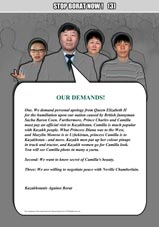 The movie by Sacha Baron Cohen “Borat: Cultural Learning of America for Make Benefit Glorious Nation of Kazakhstan” became a world hit in 2006. Historically, Kazakhstan was always one of the most secret regions due to a complicated set of historical circumstances as well as the Soviet Unions' design to create Kazakhstan as a secret space center and a nuclear testing ground. This helps to explain why people here were shocked to hear about themselves for the first time so openly with such mischaracterizing information and tried to save their reputation by issuing patriotic articles. The author of “Stop Borat Now!” suggests that we need to take diversity of opinions as it is or as the actor advises us to take it with humor. The author supports this view, saying:”Borat is not right. There is no sex in our country”. This phrase is taken from another famous TV talk-show called Phil Donahue some 20 years ago which joined a Soviet and American audience. One Soviet woman participating in this TV show tried to reject anything from the West, offering this phrase which became a symbol of the closed Soviet society. Who controls the media, control the world.
The movie by Sacha Baron Cohen “Borat: Cultural Learning of America for Make Benefit Glorious Nation of Kazakhstan” became a world hit in 2006. Historically, Kazakhstan was always one of the most secret regions due to a complicated set of historical circumstances as well as the Soviet Unions' design to create Kazakhstan as a secret space center and a nuclear testing ground. This helps to explain why people here were shocked to hear about themselves for the first time so openly with such mischaracterizing information and tried to save their reputation by issuing patriotic articles. The author of “Stop Borat Now!” suggests that we need to take diversity of opinions as it is or as the actor advises us to take it with humor. The author supports this view, saying:”Borat is not right. There is no sex in our country”. This phrase is taken from another famous TV talk-show called Phil Donahue some 20 years ago which joined a Soviet and American audience. One Soviet woman participating in this TV show tried to reject anything from the West, offering this phrase which became a symbol of the closed Soviet society. Who controls the media, control the world.
Uzbekistan
Sergey Tychina and Vyacheslav Akhunov
Vyacheslav was born in 1948 and lives in Tashkent . He graduated from the Moscow Art Institute. Major exhibitions: “No Mad's Land” (House of World Culture, Berlin, 2002), “Transforma” (Center for Contemporary Art – Geneva, 2002), “VideoIdentity” (SCCA- Almaty, 2004), 51st Venice Biennale (Central Asian Pavilion, 2005), “In the Shadow of Heroes” (Bishkek, Alatoo Square, 2005), “Film Focus” (Z33, Hasselt, Belgium, 2006), “Contemporary Art from Central Asia” (Uazdovski Palace, Warsaw, 2006), “Peace Rose” (Spiridonov House, Moscow, 2006), 2nd Singapore Biennale (2006), “Turbulence” (3rd Oakland Triennale, New Zealand, 2007), “Constellation-2” (Tashkent, 2007), Thermocline (ZKM, Karlsrue, 2007).
Sergei Tychina was born in 1960 and lives in Tashkent . He graduated from the Tashkent Theater and Art Institute. Major exhibitions: “… and others” (Art Muzeum, Bishkek, 2004), “Video Identity” (SCCA, Almaty, 2004), 51st Venice Biennale (Central Asian Pavilion, 2005) “In the Shade of Heroes” (Bishkek, Alatoo Square, 2005), Film Focus (Z33, Hasselt, Belgium, 2006), “Contemporary Art from Central Asia” (Uazdovski Palace, Warsaw, 2006), “Peace Rose” (Spiridonov House, Moscow, 2006), “Turbulence” (3rd Oakland Triennale, New Zealand, 2007), “Constellation-2” (Tashkent, 2007)
 “Corner”, 2004. Video, 9 min
“Corner”, 2004. Video, 9 min
The authors visualize the problem of irreparability (interminability), ignoring the personality, the society itself. The man is looking for solutions, for answers to his questions and can not find them among the ancient building of Samarkand, he has no way out from small streets between mosques and medrese (islamic schools), which describes perfectly the contradictions of the modern Uzbekistan.